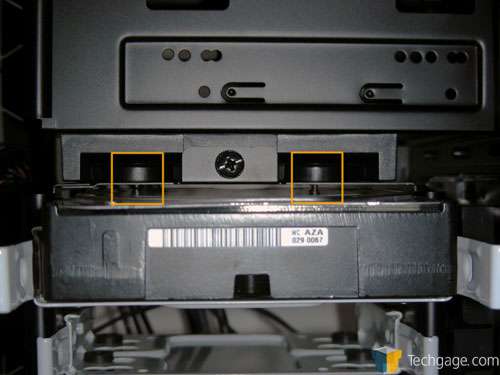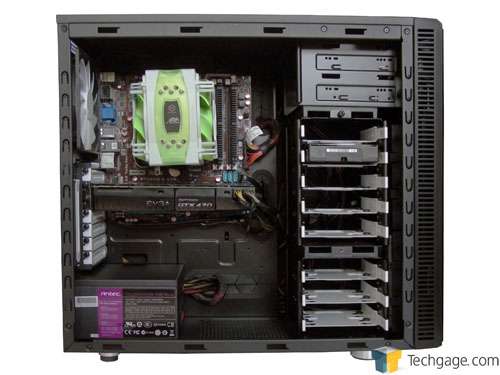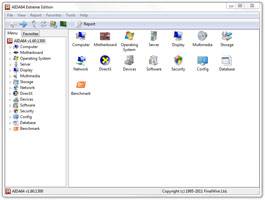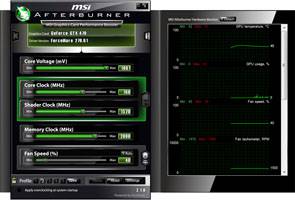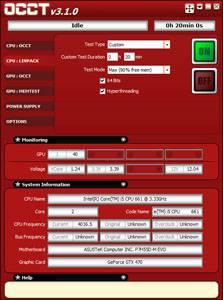- Qualcomm Launches Snapdragon 4 Gen 2 Mobile Platform
- AMD Launches Ryzen PRO 7000 Series Mobile & Desktop Platform
- Intel Launches Sleek Single-Slot Arc Pro A60 Workstation Graphics Card
- NVIDIA Announces Latest Ada Lovelace Additions: GeForce RTX 4060 Ti & RTX 4060
- Maxon Redshift With AMD Radeon GPU Rendering Support Now Available
Fractal Design Define R4 Mid-Tower Chassis Review

Where desktops are concerned, some may consider bigger to be better, but sometimes, there’s nothing quite as satisfying as a simple, classy-looking PC that you can barely hear. Helping to make that scenario a reality is Fractal Design, with its sound-dampened mid-tower Define R4. Let’s check it out.
Page 2 – Installation & Testing
The Define R4 made installation a breeze, but there was one snafu. When installing a 3.5″ drive into the top slot of the cage, the two screws used to secure the plastic guide made contact with the top of the drive. This is due to the fact that the drive sits on thick rubber washers used to absorb vibrations, which raises it slightly.
There are a few ways to get around this, the easiest of which is to use the second tray down. The other options are to remove the two screws and grind them down 1/16″ or not use the rubber washers at all so the drive rests directly on the tray.
We decided to go with the first option and installed our test drive into the second bay. Everything else lined up perfectly and there was ton of room to work. The build quality was also incredible with no flexing observed anywhere.
There’s almost a full inch of clearance between the back of the motherboard tray and the right panel, so tucking cables away shouldn’t be a problem either.
With everything in and all of the wires connected, here’s what most folks can expect to see when all is said and done.
As mentioned earlier, we’ve made a change to our test system and have swapped out the Corsair H60 all-in-one liquid CPU cooler in favour of the Thermaltake Jing air cooler. This change was made so that we can get a more accurate read on just how well a case can radiate and vent heat to the outside.
Please note that even though the Jing looks a little skewed, CPU contact is perfect as the pressure is equal all the way around and the base is large enough to cover the entire chip.
Testing
All of our testing is performed in a near steady 20°C ambient environment with readings taken before and after with a standard room thermometer. AIDA64 Extreme Engineer is used for monitoring and recording all system temperatures throughout the testing process.
Windows is allowed to sit idle for 10 minutes after startup to ensure all services are loaded before recording the idle CPU and GPU temperatures. CPU load temperatures are generated by performing a 20 minute run of OCCT LINPACK using 90% of the available memory, while GPU load temperatures are generated by OCCT’s built in test, also for 20 minutes.
Stock CPU settings were obtained by setting the AI Tweaker option with the BIOS to Auto and the maximum stable overclock frequency of 4.0GHz was obtained after extensive testing to ensure stability. The final clocks for the GPU are 760MHz on the core and 1000MHz QDR (4000MHz relative) for the memory with the voltage increased to 1.087V using MSI’s Afterburner overclocking utility. As with the CPU overclock, testing was done prior to ensure full stability.
The components used for testing are:
| Techgage Chassis Testing System | ||||
| Processor | Intel Core i5-661 – Dual-Core (3.33GHz) | |||
| Motherboard | ASUS P7H55D-M EVO mATX – H55-based | |||
| Memory | Corsair Dominator 2x2GB DDR3-1600 7-8-7-20-2T | |||
| Graphics | EVGA GeForce GTX 470 | |||
| Storage | Western Digital 2TB Green | |||
| Power Supply | Antec TP-750 Blue | |||
| Chassis | Cooler Master Cosmos II Cooler Master HAF 932 Advanced Cooler Master Storm Scout 2 Corsair Carbide 400R Corsair Obsidian 550D Corsair Obsidian 650D Corsair SE White 600T Fractal Design Define R4 NZXT Switch 810 Silverstone Raven RV03 Thermaltake Chaser MK-1 Thermaltake Level 10 GT |
|||
| CPU Cooling | Corsair H60 (Exhaust Configuration) (All but Define R4) Thermaltake Jing (Only Define R4) |
|||
| Et cetera | Windows 7 Ultimate 64-bit | |||
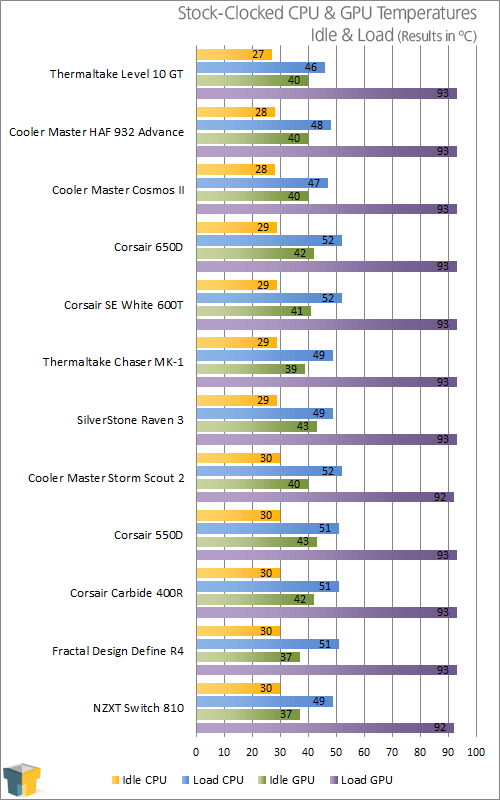
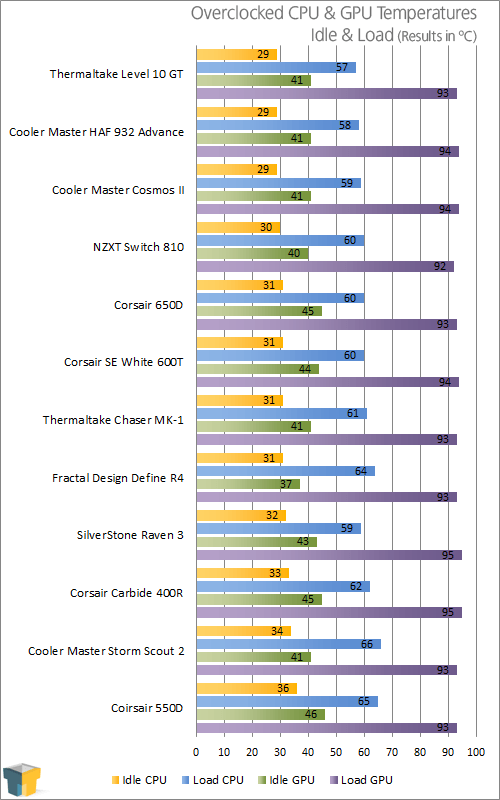
For the sake of time, we weren’t able to retest other cases that we’ve looked at in the past using this new configuration, but have included those numbers so readers can compare. After seeing the results, it looks like this change is doing exactly what we expected. We are now relying solely on the case fans to vent the warm air and not the CPU cooler.
If we look at the Antec SOLO II, which is another “silent” case that had a similar stock cooling setup, but used the H60, we see that the Define R4 matched the overclocked load temperatures, although the SOLO II used 120mm fans whereas the Define R4 uses 140mm.
Our CPU stayed under the thermal limit (69.8ºC) and GPU temperatures remained on par with testing thanks to a very powerful, but very noisy fan.
Speaking of the GPU fan, it sounds like a leaf-blower when temperatures exceed 90 degrees, but thanks to the foam on the front door, lining on the side panels and the inserts over the unused fan areas, the R4 stayed as quiet as possible. While we didn’t measure sound levels with any instrumentation, from my experience it proved to be the quietest case we’ve ever tested.
Did my first experience with a Fractal Design case meet or exceed my expectations?
Support our efforts! With ad revenue at an all-time low for written websites, we're relying more than ever on reader support to help us continue putting so much effort into this type of content. You can support us by becoming a Patron, or by using our Amazon shopping affiliate links listed through our articles. Thanks for your support!




